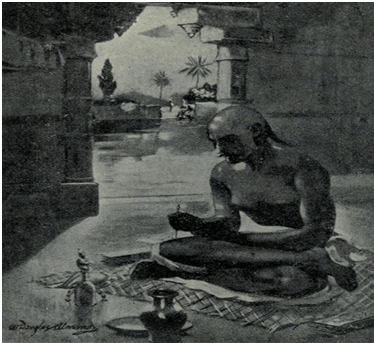Missing Ancient Indian Science in our school syllabus
By SubhashKak
There were many sciences based on fundamental principles and empirical observations and without any mention of gods. There are some sutras that are primarily philosophical, description of practices, and discursive. Students would only benefit from studying these texts and would surely aid in further research of the present scientific disciplines.
The best universities in the West prepare intellectual leaders of tomorrow using a classics-based curriculum which includes the earliest texts of the western tradition. Educators in India have also begun to speak of a similar classics-based curriculum for India.
Such emulation of the western liberal studies curriculum must include scientific classics. This will help the student get a sense of the historical changes associated with the Indian sciences and understand the relationship of these sciences to other aspects of culture.
But there is general ignorance about India’s scientific tradition. It is granted that Indians had philosophy and religion, Ayurveda, mathematics and the symbol zero, but it is believed that there was little hard science.
Nothing could be farther from the truth. India had many sciences that were based on fundamental principles, axioms, logical inference and empirical observations. These sciences, in which there is no mention of gods or anything that a modern scientist will consider unreasonable, were generally written down in texts that were called śāstras and sūtras.

The attraction of a piece of iron to a magnet is mentioned in the epic poem Kumārasambhava by the poet Kālidāsa.
A śāstra is a discipline that is obtained using the instrument (śastra) of logic. The word sūtra, Sanskrit for thread, is cognate with the Latin sutura (or English, suture), which is the silken thread that was used to hold the seam together after surgery. A sūtra is a pithy representation of a key element of the knowledge basis. Taken in totality, the sutras, together with a commentary, provide a full representation of the science.
There are some sutras that are primarily philosophical, description of practices, and discursive. Some of the more famous mathematical treatises before the astronomical siddhāntas of Āryabhaṭa, Brahmagupta and their successors are the Śulba-sūtra (SS) of Baudhāyana, the Chandaḥ-sūtra (CS) of Piṅgala, and the Nyāya-sūtra(NS) of Gotama.
SS is the subject of geometry and it includes the Pythagoras theorem several centuries prior to its later discovery in Greece; CS is the mathematics of meters and it includes the earliest description of binary numbers, which now are at the basis of computers; and NS is the first formal description of logic, which predates the logic of Aristotle. Combinatorics is also to be found in the NāṭyaŚāstra of Bharata Muni.
Indians were not only into theory and abstract speculation. Apart from the careful study of motion, vibratory phenomena, acoustics and transforming the power of fire were studied. It was known that lightning bolts had electricity. Magnetism, which was also known and the SuśrutaSaṃhitā, speaks of how a loose unbarbed arrow lodged in a wound with a broad mouth can be withdrawn by the use of a magnet. A compass consisting of an iron fish floating in a pan of oil is described. The attraction of a piece of iron to a magnet is mentioned in the epic poem Kumārasambhava by the poet Kālidāsa.
There are accounts of temples with levitating images as in Somnath, which was destroyed by Mahmud of Ghazni in 1025-1026. When the temple fell, “the king directed a person to go and feel it all around with a spear, which he did but met with no obstacles. One of the attendants then stated his opinion that the canopy was made of loadstone (a magnetised rock), and that the idol was iron and that the ingenious builder had skillfully contrived that the magnet should not exercise a greater force on any one side — hence the idol was suspended in the middle. When two stones were removed from the summit the idol swerved on one side, when more were taken away, it inclined still further, until it rested on the ground”.
I want to speak now of one of the greatest early classics of Indian science which was not discussed in the Encyclopedia of India edited by Stanley Wolpert. This is the Vaiśeṣika-sūtra (VS) of Kaṇāda. This is physics which includes laws of motion as well as general principles to describe the physical reality. I recently translated and analysed VS under the title Matter and Mind: The VaiśeṣikaSūtra of Kaṇāda.
Kaṇāda in his sutras enumerates real entities irrespective of whether they can be perceived through the sense organs or not. These are the building blocks of Kaṇāda’s world described through their attributes and motion.
The Vaiśeṣika system has categories not only for space-time-matter but also for attributes related to the perception of matter. It starts with six categories that are nameable and knowable. Nothing beyond these six fundamentals is necessary, because they are sufficient to describe everything in the universe from concrete matter to the abstract atom. The six categories are substance, quality, motion, universal, particularity, and inherence. Of the six categories, the basic one is that of substance and the other five categories are qualities associated with the substance.
There are nine classes of substances, some of which are non-atomic, and some atomic. Every substance was taken to be composed of four different kinds of atoms, two of which had mass and two did not.
Kaṇāda in the VS presents laws of motion and two of them almost read identical to Newton’s laws of motion. It also deals with laws and symmetries, atoms and molecules, transformations and evolution. It argues that molecules can inter-transform and amongst the effects it describes is that of electricity and magnetism. It was presumed that the atom underlying fire and light was at the basis of the electric and magnetic phenomena.








